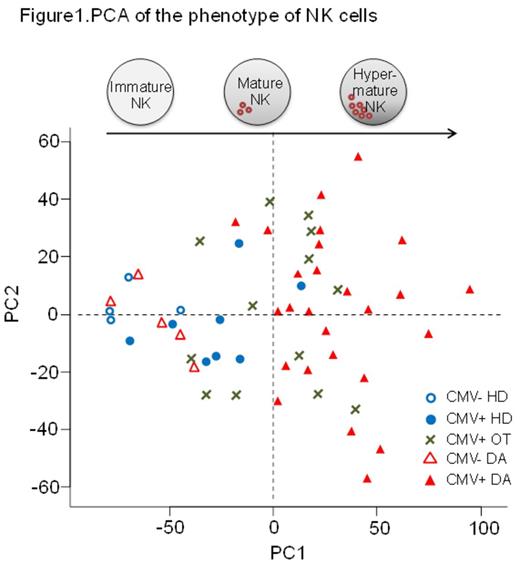Abstract
[Background] Tyrosine kinase inhibitors (TKIs), imatinib, nilotinib and dasatinib are key drugs for the treatment of Philadelphia chromosome-positive (Ph+) leukemia. Among these TKIs, only dasatinib expands large granular lymphocytes (LGLs) including NK cells in some patients. This dasatinib-induced lymphocytosis is associated with enhanced therapeutic responses. Recently, it has been suggested that dasatinib-associated LGL expansion is linked to cytomegalovirus (CMV) reactivation. CMV infection induces substantial changes in phenotypic and functional profiles of NK cells. However, characteristics of NK cells in dasatinib-treated Ph+ leukemia patients (DA) and mechanisms by which dasatinib expands NK cells remain unknown.
[Method] NK-cell marker expression and cytotoxic activity of NK cells were examined in 31 DA, 15 patients treated with other TKIs (OT) and 15 healthy donors (HD). We mapped NK-cell profiles, using principal component analysis (PCA) of 19 NK-cell markers.
[Result] NK cells increased in 18 of 26 CMV-seropositive (CMV+) DA, in contrast to no increase in 5 CMV- DA and 13 CMV+ OT. Expression of an activating receptor NKG2C was enhanced on the increased NK cells. PCA mapped NK-cell profiles according to the degree of differentiation, which correlated with higher expression of NKG2C, CD57 and LIR-1, and lower expression of NKp30 and NKp46, revealing that NK cells in CMV+ DA were highly differentiated compared to those in CMV- DA and HD (Figure 1). NK cells in CMV+ OT were mapped between CMV+ DA and HD. In 10 CMV+ DA, recent CMV reactivation was detected by CMV IgM and/or quantitative PCR. Of these, CMV reactivation was symptomatic only in 4 patients, indicating that dasatinib induces subclinical CMV reactivation in the majority of patients. CD107a degranulation assay showed higher cytotoxic activity of NKG2C+ NK cells, compared to NKG2C- NK cells. Interestingly, some of the CMV+ patients with Ph+ leukemia had NKG2C+ highly differentiated NK cells already at diagnosis, suggesting that CMV has been reactivated before starting TKIs at least in some patients. In fact, we detected CMV genome by nested PCR in PBMCs from some of the pretreatment patients. Moreover, the CMV+ patients with highly differentiated NK cells developed NK-LGL expansion earlier after starting dasatinib, compared to those with less differentiated NK cells.
[Discussion] Our data indicate that CMV seropositivity underlies the development of NK-LGL expansion in DA patients. Intriguingly, it appears that CMV has been subclinically reactivated at least in some Ph+ leukemia patients even before starting dasatinib, leading to expansion of "ready-to-go" NKG2C+ highly differentiated NK cells. It is likely that dasatinib further expands such NK cells presumably due to chronic stimulation by reactivated CMV. The NKG2C+ NK cells have high cytotoxic activity against leukemic cells, which might contribute to enhanced therapeutic responses in DA patients. The phenotypic profile of NK cells at diagnosis may be a strong predictor of NK-LGL expansion during dasatinib therapy.
No relevant conflicts of interest to declare.
Author notes
Asterisk with author names denotes non-ASH members.



This feature is available to Subscribers Only
Sign In or Create an Account Close Modal